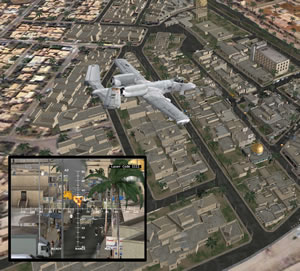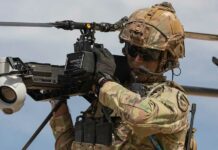One of the main drivers for change in the military’s training process is the requirement for better interoperability, or ‘jointness’ among multi-service and multi-national forces. A typical example for how a simulation tool enables better performance of air and ground forces is Joint Terminal Attack Controller (JTAC). The JTAC is the link between the Army and the Air Force when combat requires the aid of close air support. A JTAC must maintain situational awareness, know the supported unit’s plans, and validate and prosecute targets of opportunity. Training JTACs requires equipping them with the skill sets associated with air strike control, which includes in-depth knowledge of the capabilities and limitations of air power and advising the maneuver commander how best to employ it. In addition, the JTAC must determine which actions to take to properly control the ensuing air operations and how best to maximize support, which type of weapons to use, and where to direct the strike. For effective close support missions, anticipating which type of aircraft should be used, and how best to use each one, is crucial.
The US Air Force is currently developing a simulator for these ground based elements, to be fully interoperable with the A-10C Full Mission Trainers and the Multiple Unified Simulation Environment (MUSE)/Air Force Synthetic Environment for Reconnaissance and Surveillance (AFSERS) program. These systems all use common, real-time 3D visualization software developed by MetaVR.
Training Tactical Air Operations Simulation (TAOS) aims at the creation and combining virtual theater air assets and key human players to simulate the performance of command and control nodes such as air and space operations centers and other air power managers and users such as Joint tactical air controllers. TAOS combines simulations of strike; command and control; intelligence, surveillance, and reconnaissance assets; sensor simulations; and human performance model-based synthetic players to provide scaleable, flexible and adaptable representations of theater air operations with which Warfighters can interact to perform mission tasks. The military can apply the TAOS technology to training, test and evaluation, or mission rehearsal.
For the training of air crew, different approaches are used in developing individual and cooperative skills among aircrews. SAIC’s new air mission trainer (AMT) is based on our virtual trainer product line. The AMT establishes a flexible technical baseline that can easily support the implementation of both fixed- and rotary-wing flight variants. The AMT immerses the student in a rich and dynamic synthetic environment with more than 20 specific geographic locations and 40 real-world airfields. The AMT is a network simulator that can link pilots together to fly in the same airspace. Ground simulators, such as the Common Driver Trainer (CDT), also can be integrated into the same battlespace, providing the platform to conduct mission training in a Joint environment. The first variant implemented in the AMT program is the rotary wing variant (RWV). The RWV uses a high fidelity, rotary-wing cab that simulates the Bell 206/ OH-1 family of helicopters. The simulator runs on Microsoft ESP and mounted on a full-motion, six-degree-of-freedom platform that provides additional stimuli as participants execute their collective and command-and control tasks.
 An ongoing program designed to improve piloting skills of army aviators, is AVCATT, built by Link Simulation & Training. The system provides a virtual multiple training positions networked in a ‘multiplayer war-game’ like simulator providing an interactive, networked environment to support individual, crew, collective and combined arms training. The system is based on virtual, realistic training environment supported by intelligent, semi-automated forces (SAF). Following the simulated battle exercise, aircrews can review and analyze their mission performance through an After Action Review debriefing process. The system uses reconfigurable simulators supporting a full mission spectrum undertaken by the services’ attack, reconnaissance and utility helicopters, simulating AH-64A Apache, OH-58D Kiowa Warrior, UH-60 Blackhawk, CH-47D Chinook and AH-64D Longbow platforms.
An ongoing program designed to improve piloting skills of army aviators, is AVCATT, built by Link Simulation & Training. The system provides a virtual multiple training positions networked in a ‘multiplayer war-game’ like simulator providing an interactive, networked environment to support individual, crew, collective and combined arms training. The system is based on virtual, realistic training environment supported by intelligent, semi-automated forces (SAF). Following the simulated battle exercise, aircrews can review and analyze their mission performance through an After Action Review debriefing process. The system uses reconfigurable simulators supporting a full mission spectrum undertaken by the services’ attack, reconnaissance and utility helicopters, simulating AH-64A Apache, OH-58D Kiowa Warrior, UH-60 Blackhawk, CH-47D Chinook and AH-64D Longbow platforms.
Other capabilities are required to simulate communications between pilots and air traffic controllers. The ability to automatically generate speech is invaluable in situations where it is required to represent a number of external agencies or operators within a simulated environment. However, voice quality of synthesized speech systems had, up until recently, left much to be desired. Voice generation expert ASTi has introduced improved speech generation algorithms which, backed by the increase in computing power, have resulted in more natural sounding speech. This year, the company integrated off-line speech message generation as a package option to its T4 product suite – a useful feature for Air Traffic Management and flight simulation systems. Further improvements are now available with multiple voices and tones, depicting different accents and language variations. The tight integration of Automated Speech Recognition (ASR) capabilities and synthetic speech, now allows ASTi to look toward the development of exciting new capabilities such as Automated Air Traffic Control systems (ATC). With this system, synthetic ATC controllers can direct live man-in-the-loop pilots sitting in the cockpit of a simulator through an air space crowded with CGF generated traffic, while listening to context relevant radio chatter.
 The soaring cost of flight simulators drove system developers to seek alternative display systems that could minimize the space and lower the cost of flight training. One of the latest innovations from Link is the new Advanced Helmet Mounted Display, delivering a 360° field-of-regard to support virtual training and augmented operational reality. The helmet mounted display uses new optics and illumination design, employing solid-state near-eye micro displays, enabling AHMD to provide unmatched contrast, brightness and vivid color for all types of imagery. The system can be coupled with Link’s Night Vision Training System assisting pilots to practice the challenging limitations of development of situational picture using ANVISS night vision goggles. Link’s integrated product solution couples the image generation system, NVG sensor simulation, head tracking, NVG goggle displays and correlated databases to provide the answer to realistic NVG simulation.
The soaring cost of flight simulators drove system developers to seek alternative display systems that could minimize the space and lower the cost of flight training. One of the latest innovations from Link is the new Advanced Helmet Mounted Display, delivering a 360° field-of-regard to support virtual training and augmented operational reality. The helmet mounted display uses new optics and illumination design, employing solid-state near-eye micro displays, enabling AHMD to provide unmatched contrast, brightness and vivid color for all types of imagery. The system can be coupled with Link’s Night Vision Training System assisting pilots to practice the challenging limitations of development of situational picture using ANVISS night vision goggles. Link’s integrated product solution couples the image generation system, NVG sensor simulation, head tracking, NVG goggle displays and correlated databases to provide the answer to realistic NVG simulation.
Other topics covered in this review:
- Simulation & Training technologies at I/ITSEC 2007
- Populating the Virtual Worlds
- Training and Simulation for the First Responders
- Practicing Air/Ground Missions

















